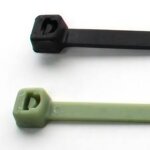What Are Cable Ties with Metal Pigments?
Cable ties with metal pigments are standard nylon or polymer-based cable ties infused with metal particles. This addition makes them detectable by X-ray machines and metal detectors, enabling quick identification and removal if they accidentally enter production lines. Their bright blue color further aids visual inspections.
Safety Considerations

Material Composition
The metal pigments used in these cable ties are typically embedded in the polymer matrix during manufacturing. This ensures:
- No Leaching: The metal particles remain securely bonded within the plastic, minimizing the risk of contamination.
- Non-Toxicity: High-quality detectable ties are made from food-grade materials, ensuring they do not release harmful substances into products.
Compliance with Standards
Cable ties meet stringent industry standards, including:
- HACCP Compliance: Supporting hazard prevention in food and beverage production.
- FDA Approval: Ensuring safe use with food products.
- ISO 22000: Aligning with global food safety management systems.
These certifications demonstrate that cable ties with metal pigments are safe when sourced from reputable manufacturers.
Durability and Reliability
Safety concerns can also arise if cable ties degrade under environmental stress. However, metal-pigmented cable ties are engineered to perform reliably in various conditions:
- Resistance to Extreme Temperatures: They maintain integrity under high heat or freezing conditions.
- Chemical Compatibility: Designed to resist cleaning agents and other harsh chemicals common in manufacturing environments.
Detection and Traceability
The detectability of these cable ties enhances safety by preventing foreign object contamination. Metal pigments allow rapid identification through scanning systems, making them a proactive solution for maintaining product integrity.
Potential Risks and How to Mitigate Them

While cable ties with metal pigments are generally safe, certain risks can arise:
- Use of Substandard Products
Poorly manufactured cable ties may lack proper bonding of metal particles, increasing contamination risks.
Solution: Always source ties from trusted manufacturers with certifications like HACCP and FDA approval. - Inappropriate Application
Using the wrong size or type of cable tie for a specific task may lead to mechanical failure.
Solution: Match the tie’s tensile strength, size, and material to the application. - Improper Disposal
If broken ties are not properly discarded, fragments may pose a contamination hazard.
Solution: Implement strict disposal protocols and use detection systems to identify tie fragments.
Benefits of Cable Ties with Metal Pigments
Despite potential risks, the benefits of detectable cable ties make them invaluable in safety-critical industries:
- Enhanced Contamination Prevention: Rapid identification and removal of foreign objects.
- Regulatory Compliance: Supporting adherence to food safety and quality standards.
- Reduced Product Recalls: Preventing costly recalls caused by contamination incidents.
Learn more: HACCP Compliance: Why Detectable Cable Ties Are Non-Negotiable
Wrapping Up
Cable ties with metal pigments are a safe and effective solution for industries requiring traceability and contamination prevention. Their design ensures durability, non-toxicity, and compliance with rigorous safety standards. By choosing high-quality products and following best practices, manufacturers can confidently use these ties to enhance safety and maintain product integrity.
For more insights and tips on cable ties and other related products, explore cabletiesunlimited.com and follow us on our social media communities on Facebook and Instagram!

